

Are You Confused by Scientific Jargon? So Are Scientists. Polje, nappe, vuggy, psammite.
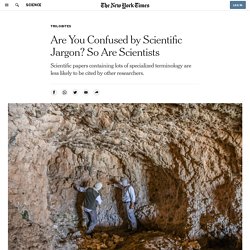
Some scientists who study caves might not bat an eye, but for the rest of us, these terms might as well be ancient Greek. Specialized terminology isn’t unique to the ivory tower — just ask a baker about torting or an arborist about bracts, for example. But it’s pervasive in academia, and now a team of researchers has analyzed jargon in a set of over 21,000 scientific manuscripts. They found that papers containing higher proportions of jargon in their titles and abstracts were cited less frequently by other researchers. Science communication — with the public but also among scientists — suffers when a research paper is packed with too much specialized terminology, the team concluded.
These results were published Wednesday in Proceedings of the Royal Society B. How to Write Undergraduate Essays — Tim Squirrell. Summary: read the reading list, don’t read books cover to cover, find additional articles in bibliographies of reading list articles, skim abstracts for relevance, write down notes with page numbers and quotes. Read critically. Unless you’re Foucault (and you’re not Foucault), then the foundation of any good essay is a solid set of references. This isn’t just so that you can look good and your tutor thinks you’ve done the reading. It’s because, no matter how clever you are and what percentile of the country you came in your school leaving exams, your ideas still aren’t original.
Trust me. Look at the reading list. Make sure you take notes on everything you read. You don’t want to get penalised because you didn’t reference your readings properly after you’ve put in all that effort to make sure that your arguments are founded in the literature. Poor citation practices are continuing to harm the humanities and social sciences. Citation and referencing patterns are not trivial things but solid and important indications of the presence of primary academic virtues.

Patrick Dunleavy looks at disciplinary differences and argues the poor citation practices in the humanities and social sciences are therefore not just harmful to academics, but to all who read their works or follow after them. To break past such attitudes requires a collective effort to get to a better understanding of the existing literatures on the myriad topics covered. There is a huge gulf between many STEM scientists (in science, technology, engineering and mathematics) and scholars in other disciplines in how often they cite other people’s research in explaining their own findings and arguments.
My first chart shows that the citation rate (defined as total citations divided by the number of publications)is eight times greater in medical and life sciences than in the humanities (including law and ‘art’ subjects here). What should or can be done? Statlets. Plagiarism Checker. A list of key features: 1.
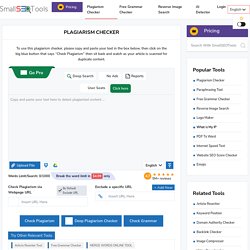
Billions of web pages This tool has the ability to check plagiarism by matching your content against billions of webpages on the Internet. Once you upload your content, it will automatically run it against every existing content on the web within seconds, making it the most sophisticated yet fastest plagiarism scanner you'll ever come across in your lifetime. 2. It has an option for automatically rewriting the content you run on it in just one click. 3. Promoting development and uptake of health innovations: The Nose to Tail Tool. Development of the NTT From the primary literature we identified sixteen commonly described stages of innovation development: (1) identify the problem12,17–24, (2) develop the innovation15,21,22,24–31; (3) design the pilot test17,22,29–31; (4) pilot test; (5) evaluate the pilot test13,22,24–26,31–34; (6) decide to implement12,15,17,19,21,22,28,35–41; (7) plan the implementation15,17,21–25,27,28,33,35–40,42–49; (8) implement; (9) evaluate the implementation22–27,31,32,42,48,50–53; (10) test for extensibility25,26,31,51,53,54; (11) decide to scale up12,18,20,52,53,55–59; (12) plan the scale up12,13,20,27,31,33,34,36,42,47,52,55–67; (13) scale up; (14) evaluate the scale up11,18,31,42,52,68; (15) monitor the scale up17,36,56,68; and (16) institutionalize12,13,42,47.

These sixteen stages are used as the rows of the NTT grid (Figure 1). Making sense of data: How safe is cycling? Cycling in Britain is often perceived as dangerous, but how much have the risks of riding a bike changed, and how do they compare with driving a car, asks statistician Jamie Jenkins.
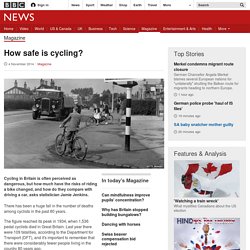
There has been a huge fall in the number of deaths among cyclists in the past 80 years. The figure reached its peak in 1934, when 1,536 pedal cyclists died in Great Britain. Last year there were 109 fatalities, according to the Department for Transport (DFT), and it's important to remember that there were considerably fewer people living in the country 80 years ago. But before we think that 1934 was a bad year for cycling, remember that despite the lower population there are likely to have been far more cyclists. Owning a motor vehicle was much rarer and thus cycling as a primary means of transport would have been more common. We do not know exactly how many cycle journeys there were in 1934, but the number of licensed cars on the road can give us some indication.
Review: Managing change in the NHS: change management. Newsletter 109: NCCMT Weekly Round-up - Check out the new look in the Learning Centre! Health in overweight children: 2-year follow-up of Finnmark Activity School-a randomised trial.
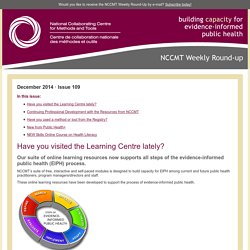
OBJECTIVE: To compare a comprehensive lifestyle intervention for overweight children performed in groups of families with a conventional single-family treatment. Two-year follow-up data on anthropometric and psychological outcome are presented. DESIGN: Overweight and obese children aged 6-12 years with body mass index (BMI) corresponding to >/=27.5 kg/m2 in adults were randomised to multiple-family (n=48) or single-family intervention (n=49) in a parallel design. Multiple-family intervention comprised an inpatient programme with other families and a multidisciplinary team, follow-up visits in their hometown, weekly physical activity and a family camp. Single-family intervention included counselling by paediatric nurse, paediatric consultant and nutritionist at the hospital and follow-up by a community public health nurse.
The full text may be available from PubMed. Video: creating a boxplot graph in SPSS. Video series: skills and competencies for careers in public health.
One of a series of videos about careers in global health – mcquillan_ruth
Study skills: What's the best, most effective way to take notes? If it feels like you forget new information almost as quickly as you hear it, even if you write it down, that’s because we tend to lose almost 40% of new information within the first 24 hours of first reading or hearing it.
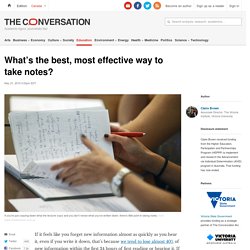
If we take notes effectively, however, we can retain and retrieve almost 100% of the information we receive. Learning how to retain information The most effective note-taking skills involve active rather than passive learning. Active learning places the responsibility for learning on the learner. Skills: how to find a book using Edinburgh University Library.